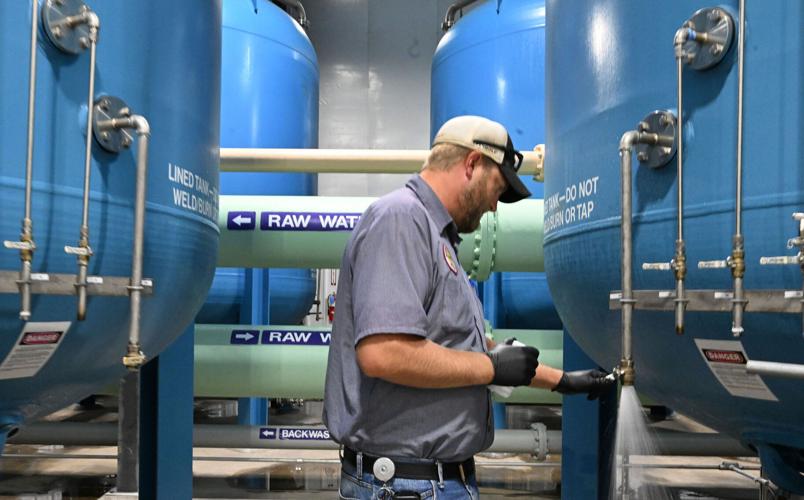AG Weiser joins Colorado with 22 other states over 3M PFAS settlement

This zoomed-in version of the nationwide map provides a better look at Colorado specifically. A full map key can be found above. A white dot indicates no PFAS detected, while the blue circles indicate detection with the size indicating number of PFAS detections (larger size means more PFAS). Map Credit: USGS, public domain.
Colorado has joined a multi-state coalition of 22 attorneys general opposing a proposed class-action settlement with the 3M Company over the decades-long use of so-called “forever chemicals” in consumer products and firefighting foams.
Attorney General Phil Weiser announced his opposition to the proposed settlement, saying it fails to adequately hold the company accountable for “contaminating Americans’ drinking water.”
”Coloradans now suffer degraded water quality and public health injuries on account of the actions of 3M and other companies who manufactured and marketed PFAS,” said Weiser in a release. “By taking action today, we are standing up for our citizens and fighting for an adequate and appropriate resolution of the ongoing litigation.”
Weiser filed a lawsuit in early 2022 against 15 manufacturers of firefighting foam containing PFAS for “damages and injuries that these toxic chemicals have caused to Colorado’s public health and natural resources.”
The objection filed by the states says that the settlement infringes on the state’s rights to control pollution and puts thousands of drinking water providers at risk of having to indemnify 3M against claims made for PFAS-related lawsuits that might come up in the future. Weiser also says the settlement would interfere with the state’s sovereign rights to pursue Colorado’s claims against the company.
The proposed settlement agreement comes in a case brought by the city of Stuart, Florida, which avoided a trial scheduled for early June. Some 300 other communities have filed similar suits against companies that made firefighting foam or PFAS. Certification as a class action lawsuit would bind all members of the class to its provisions.
According to the Associated Press, the settlement could reach as high as $12.5 billion, depending how many public water systems detect PFAS in response to an order from the EPA to test during the next three years.
The cases are pending in U.S. District Court in Charleston, South Carolina, where Judge Richard Gergel is overseeing thousands of complaints alleging PFAS damages. A trial of a complaint by the Florida city had been scheduled to begin this month but was delayed to allow time for additional settlement negotiations, said the AP.
The Agency for Toxic Substances and Disease Registry, a federal public health agency of the U.S. Department of Health and Human Services tasked with investigating environmental exposures to hazardous substances, released a nearly 1,000 page report on PFAS and the toxic effects on both animals and humans of 12 different kinds of PFAS chemicals in May 2021.
Notably, despite more than 600 studies going back at least as far as 1993, the report does not conclude that a cause-and-effect relationship exists between PFAS and human health problems.
“Although a large number of epidemiological studies have examined the potential of perfluoroalkyls to induce adverse health effects, most of the studies are cross-sectional in design and do not establish causality,” said the report.
“Based on a number of factors, the available epidemiological studies suggest associations between perfluoroalkyl exposure and several health outcomes; however, cause-and-effect relationships have not been established for these outcomes:”
• Pregnancy-induced hypertension/pre-eclampsia
• Damage to the liver
• Increases in cholesterol
• Decreased antibody response to vaccines
• Small decreases in birth weight of less than one ounce.
The International Agency for Research on Cancer reported in 2017 that “Increases in testicular and kidney cancer have been observed in highly exposed humans.”
The ATSDR emphasizes that human health impacts from high levels of PFAS “may” be a risk on its consumer website www.atsdr.cdc.gov/pfas/health-effects/index.html
In June 2022, The Environmental Protection Agency made a health advisory announcement which drastically lowers the agency’s recommendations on safe limits of PFAS in drinking water shortly after another federal agency said residents of the Security-Widefield area in El Paso County near Peterson Space Base showed elevated levels of “forever chemicals” in their blood, compared to the national average.
The EPA said its 2016 recommendation of safe maximum lifetime PFAS concentrations of 70 parts per trillion is inadequate “in light of newly available science and in accordance with EPA’s responsibility to protect public health.”
“People on the front lines of PFAS contamination have suffered for far too long,” said EPA Administrator Michael S. Regan in a news release. “That’s why EPA is taking aggressive action as part of a whole-of-government approach to prevent these chemicals from entering the environment and to help protect concerned families from this pervasive challenge.”
The new lifetime health advisory level recommendations are 0.004 parts per trillion (ppt) for PFOA and 0.02 ppt for PFOS, the two most prevalent types of PFAS.
An EPA fact sheet describes the new health advisory levels as “below the levels at which analytical methods can measure PFOA and PFOS.”





